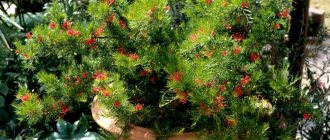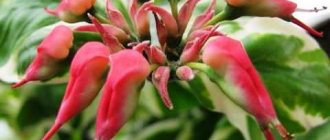floravdome.ru > Cacti and succulents > Pedilanthus flower care, photo
Pedilanthus involuntarily attracts the eye in any room. A bright, cheerful plant is rapidly gaining popularity among gardeners. In addition to its undeniable advantage - its spectacular appearance, pedilanthus is also a useful plant, having a healthy effect on the air in the room, and the essential oils contained in the leaves have a beneficial effect on human well-being. A bonus to all these advantages is the ease of caring for the flower, which allows it to grow well even with inexperienced gardeners.
Indoor flower pedilanthus (Pedilanthus) is an unpretentious evergreen plant of the Euphorbiaceae family.
Its homeland is the American tropics, where it grows in low bushes.
The bright green succulent stem can bend arbitrarily, the dense leaves of an ovoid-pointed shape shine from the wax covering them. Pedilanthus also has variegated (variegated) species.
At the end of autumn, pedilanthus can bloom with small bright pink or red flowers, collected in inflorescences. Flowering occurs in November - early December under conditions that best match natural ones. At home this happens quite rarely.
Pedilanthus variegata
Pedilanthus is a succulent plant. The flower is unpretentious and easily tolerates temporary difficulties, rearrangements, shaping and pruning.
But, in order to get a beautiful, healthy plant, you must, of course, provide the flower with suitable conditions and provide the necessary care.
Accommodation
Pedilanthus is very light-loving. Variegated species especially need light.
The best place for a flower is a windowsill on the southwest, southeast or south side. In summer, at noon, the plant is shaded from direct sunlight, but the morning and evening sun only benefits pedilanthus.
! In bright sunlight, pedilanthus leaves may take on a delicate pinkish tint.
In dark rooms and on northern or shaded windows, pedilanthus also grows, but loses all its decorative effect - the distance between the leaves increases, the branches stretch out and lose their elasticity. If it is not possible to rearrange the plant, then mandatory lighting is required.
Pedilanthus needs fresh air, but it must be protected from drafts and sudden changes in temperature. When overcooled, the plant quickly sheds its leaves and needs a long recovery.
Pedilanthus titimoloides. Leaves turn pink in the sun
Conditions for growing at home
- There is no flowering - the flower has not rested, the winter maintenance conditions were violated, for example, watering was not reduced or fertilizers were applied. Also, the cause may be a constant draft or poor lighting.
- The leaves turn pink - partial pinking of the leaves is normal, especially when the flower is in the open sun. They will never completely change the color to pink.
- Leaves fall - in winter this is also the norm if the loss does not exceed 50% of all foliage. If leaves fall during the active growing season, you should check the recommended growing rules and find the error. Most likely the reason lies in violation of watering rules or a sharp change in temperature.
Problems with caring for pedilanthus titimaloides are reflected in its decorative characteristics.
Pedilanthus blooms rarely, but very beautifully
The main care issues are discussed below.
- Pedilanthus leaves are falling off, what to do in this case? Usually he does this when there is insufficient watering or stagnation of water in the earthen coma. It is recommended to change the watering mode. Drafts are especially dangerous in winter. When the stems freeze, the leaves fall off.
- A lack of lighting is signaled by small leaves losing their bright or variegated color.
- Yellowing of leaf blades and dried, curled tips are the result of dry air or negative exposure to direct sunlight.
- If the plant does not bloom at the end of autumn, this means non-compliance with the temperature regime, lack of lighting or too short a period of winter dormancy.
Such problems can be easily dealt with by changing the watering regime or moving the flower to a new location. They are not scary, because Pedilanthus titimaloidum easily regenerates and grows foliage.
Attention! But if brown spots appear on the leaves, the foliage has fallen, and the soil in the pot has turned sour, then the plant has probably contracted root rot and needs to be urgently transplanted into new soil.
Pests of the plant are spider mites, aphids and whiteflies. They are removed with chemical compounds or a soap solution, after cutting off the damaged foliage.
An exotically beautiful, decoratively attractive indoor plant, pedilanthus titimaloidum, will be a wonderful decoration not only for the windowsill, but also for the interior as a whole. It will not cause any trouble, and if you observe a period of rest and good lighting in the summer, it will definitely bloom in the fall.
Like any succulent, pedilanthus is not too demanding. Its cultivation does not cause any particular difficulties even for novice gardeners.
The bush loves sunny windowsills, which need to be shaded during the summer heat. However, this spurge can be successfully grown even on northern windows. The plant needs to create an atmosphere of long daylight hours, even in winter - for this purpose, lighting devices with cold light are desirable so as not to disturb it during the dormant period. In summer, you can place the pot on the balcony or in the courtyard of a private house - fresh air has a beneficial effect.
Temperature
Pedilanthus titimaloides is not too picky about growing temperatures. This does not mean that it can be overheated or cooled too much, but it will withstand some “hardships”.
In summer, on a shaded windowsill the temperature should be 20... 25 °C; during the July heat, the bush will tolerate 28 °C for some time. In winter, a decrease in temperature to 18 ° C is acceptable, and at 14 ° C the leaves may fall off until spring.
Important! In winter, it is possible to keep it at higher temperatures, but the color of the leaves and flowers will suffer significantly.
Air humidity
The plant does not need spraying or installing special air humidifiers - this succulent can survive on its own for a long time and feels normal in dry air. If the air remains too dry for a long time, the plant may shed its leaves, but it will not begin to die. In case of prolonged dry weather or planning to leave for several days, you can place an open container of water near the pot.
Interesting articles:
- Pedilanthus titimaloid 23 photos flower care at home planting rules Possible diseases and their treatment
- Pedilanthus plant description, planting and care at home
- Large-flowered chrysanthemums 44 photos, growing from seeds, garden varieties of Indian chrysanthemum and other types, use of gibberellin
- Chair colors pink and red blue and turquoise black and gray purple and beige orange and blue burgundy and mustard
Air humidity
Pedilanthus tolerates normal indoor humidity levels well, but periodic spraying, especially in the morning on hot summer days or during the heating season, has a beneficial effect on it and contributes to both general health and accelerated growth.
Also, for hygienic purposes, once a month the pedilanthus is given a warm shower, which washes away the dust and stimulates the plant. After a shower, it is recommended to leave the flower in the bathroom until the leaves dry completely.
Where does it belong in the room?
Growing pedilanthus in a pot is not difficult. It is clear that “Americans” love bright sunshine. Therefore, there should also be a lot of light in the room.
In summer, the plant simply basks in the freshness; leave a place for it closer to open windows, and in a private area - on the ground, with some shading by trees.
The pot must be completely covered from rain. On winter evenings, several hours of electrical supplementary lighting are required.
Pedilanthus watering
Water the pedilanthus as needed, without drying out or over-wetting the bud. A signal for watering can be the drying of the top layer of soil by 1-1.5 cm.
Use soft water, standing for at least a day, at room temperature or slightly higher.
On summer days, when the soil dries out quickly, regular watering is required.
In winter, if the plant is kept at the required low temperature, watering is reduced to once a week, but care must be taken to ensure that the soil does not dry out completely.
! If overdried for a long time, pedilanthus can shed its leaves; if it is over-watered, its roots can rot, and it also reacts by shedding its leaves. Therefore, to maintain the healthy appearance of the flower, it is important to maintain a balance of watering.
Pedilanthus care at home
Pedilanthus does not require constant care, you just need to provide it with the right conditions for full growth and flowering.
Location and lighting
The plant has a very bright appearance, so it can be safely placed in the most prominent place in the house. In addition, thanks to it, the air is constantly disinfected and oxygenated, which is most necessary in the living room or bedroom.
The main thing is to provide the plant with sufficient lighting throughout the year. The greatest amount of sunlight will be received on the windowsill in the southern part of the house, slightly less - in the southeast and southwest.
To keep the leaves safe in the summer, the pot should be shaded at midday.
It is best to take pedilanthus under the shade of trees in the garden or onto the balcony in the summer.
Temperature
Like any tropical plant, pedilanthus loves high air temperatures.
Its maximum figures occur in the spring-summer period, when intensive growth is observed - from 22 to 26 degrees. In winter, such thermometer readings in an apartment can lead to leaves falling, especially if the pot is located next to heating appliances.
It is better to reduce the temperature to 15 degrees , providing a short period of rest for the formation of future flowers.
If the pot is on a windowsill, then when ventilating in winter, the plant should be protected from cold air. This will prevent frostbite on the leaves.
Humidity
Deciduous species of pedilanthus like periodic spraying . They allow you to wash away accumulated dust and improve your appearance.
In summer, spraying is carried out more often, which contributes to better heat tolerance.
It is important not to shower in bright sun to protect the leaves from getting burned.
Watering
The main indicator by which the need for watering is determined is loosening of the top layer of soil due to drying. From the beginning of spring until the end of flowering, regular watering in moderate quantities is required.
Tap water must first sit in an open container for at least a day so that the chlorine evaporates from it. Hard water can be softened by adding 1 tsp to it before settling. apple cider vinegar.
Advice! If you urgently need to water a flower, and the water is not prepared in advance, then you should at least pass it through a kitchen filter.
When the ambient temperature decreases, the growth of pedilanthus slows down. You also need to navigate by the top layer of soil, which now takes longer to dry - 1.5–2 weeks.
Interestingly, attentive gardeners may notice the need for watering on the plant itself: its leaves droop slightly. It is advisable to note the interval between waterings up to this point and moisten the soil 1–2 days earlier so that the leaves do not droop from lack of water.
Feeding and fertilizers
Components necessary for pedilanthus to live:
- calcium;
- iron;
- phosphorus.
Nitrogen, on the contrary, is needed in minimal quantities. There are no ready-made fertilizers specifically for pedilanthus, but mixtures for succulents are suitable for the plant.
The soil
Loose soil into which moisture and air easily penetrates is preferred. A suitable ready-made substrate is sold for cacti ; it would be a good idea to additionally saturate it with coarse sand or perlite.
To prepare soil from several components you will need:
- leaf and turf soil in equal parts, a quarter of the volume of sand or perlite;
- universal soil for indoor plants or ordinary garden soil , supplemented with sand and coconut additive.
This video talks about the features of caring for Pedilanthus at home.
Pot
The material from which the pot is made (plastic, clay or ceramic) is not fundamentally important. The main thing in the choice is the correspondence between the size of the root system and the volume of the container.
The young plant needs a small pot designed for cacti. Next, it is enough to add 1–2 cm in width and depth compared to the old one.
A pot that is too large will leave soil that is soggy that the roots won't be able to absorb moisture and it will oxidize, which encourages harmful bacteria .
To drain excess water, drainage holes are required at the bottom.
Pedilanthus transplant
Slow root growth does not require frequent replanting. This procedure is necessary in several cases.
- A flower recently purchased from a store needs to be replanted in fertile soil and a suitable pot. There is no need to rush into replanting after the plant has entered the house. It is better to wait 2-3 weeks for the pedilanthus to adapt to the new microclimate conditions, after which it will be able to tolerate the transplant.
- The pot has become too small for roots , as evidenced by roots visible through the drainage holes. Another reason for transplantation is that several years have passed since the previous procedure.
- Root diseases.
For transplantation, a suitable substrate and pot are prepared in advance.
Stages of work:
- The day before, the plant is well watered so that the earthen lump can be easily pulled out .
- Tap the walls a little and turn the pot down, holding the base of the pedilanthus, shake it out along with the soil.
- Remove most of the soil from the roots and inspect them for diseases.
- Trim the damaged roots, treat them with a solution of potassium permanganate and sprinkle with charcoal.
- Pour a drainage layer of expanded clay and a layer of new soil into the new flowerpot.
- Place the pedilanthus in the center and cover it with soil from the sides, shaking it periodically to evenly fill the spaces between the roots .
- Water and leave in partial shade for 5–7 days.
Trimming
In a short period, pedilanthus is able to grow its shoots significantly, so it must be pruned. New branches will form a lush crown . Before trimming pedilanthus, it is important to ensure your safety by wearing gloves.
The tops of stems whose length exceeds 20 cm are cut off. If the plant is given a certain crown shape, then all protruding branches are also removed from it.
As a rule, pinching is carried out in the spring as new shoots grow , and pruning is carried out before the start of the dormant period.
Also, the procedure may be necessary in case of severe leaf fall or an impressive age of the overgrown shrub. If the root system is healthy, it is necessary to prune, leaving 5–10 cm from the base of the shoots.
Bloom
To see pedilanthus bloom, you will have to wait about a year after planting . In order for the plant to have enough strength to produce buds, it requires the following conditions:
- long daylight hours and bright lighting;
- regular and moderate watering;
- complex fertilizing with a minimum nitrogen content ;
- winter holidays in a cool place;
- healthy roots and no pests.
Flowering occurs towards the end of autumn or early winter.
Pedilanthus dormant period
From late September to mid-February, pedilanthus begins a period of rest. At this time, lower the temperature to +15o - 17o. Watering is reduced to once a week, and fertilizing is stopped completely. The soil should not be allowed to dry out completely.
It is recommended to periodically spray the plant, and if the room has dry air from heating appliances, then take a warm shower once a month to maintain the humidity level and eliminate dust. The flower is placed in a “wintering” place (loggia or window sill) with a low temperature only after the leaves have completely dried.
Pedilanthus must be protected from drafts or temperature changes. When ventilating, cover the plant if cold air can get into it.
As with many succulents, dormancy for pedilanthus is an important part of proper development. At this time, the plant’s vital processes slow down and accumulate strength for the next growing season.
In addition, it is during the dormant period that flower buds are formed, therefore, if you want to achieve flowering from the pedilanthus, provide it with maximum not only active summer growth, but also the rest it needs in winter.
If the pedilanthus blooms in the fall, then a period of rest is provided for the plant after flowering ends.
Flowering pedilanthus in nature
When and how does it bloom
Only those pedilanthus bloom that have been properly cared for. When grown indoors, in most cases, pedilanthus blooms in November - December, delighting with its spectacular flower-shoe inflorescences. When the flowers fade, they should be trimmed with sharp scissors.
Pedilanthus color
Why doesn't it bloom
To understand why a plant does not produce flowers, it is important to analyze all the negative factors that affect this process:
- damage to the plant by insect pests;
- fungal diseases;
- hypothermia;
- excess nitrogen;
- dry air.
For your information! Flowering does not occur if the plant is not properly cared for during the dormant period.
Despite the exotic appearance of the inflorescences, flowering is not considered its main decorative element. Its flowers themselves are small (about 3 cm) and inconspicuous, but the bracts, the color of which can vary from soft pink to deep red, are much more interesting and bright in appearance.
Like other members of the Euphorbiaceae family, the plant contains milky sap, which is poisonous.
Forming and trimming pedilanthus
To grow a thick, lush bush, several plants are planted in one pot.
pruning is carried out at the beginning of the growing season in the spring - overgrown and weakened branches of the pedilanthus are trimmed, and the main ones are pinched at the desired height.
To maintain the shape of the bush, pinch out excessively growing branches throughout the growing season.
Old overgrown bushes can be revived by pruning all branches at a height of 5-8 cm in early spring. After pruning, the lateral buds emerge and the bush is overgrown with new branches. Fertilizing with complex fertilizer will accelerate the growth of greenery.
! Pruning pedilanthus is done only with gloves! The milky juice protruding at the cut sites is dried, and then the cuts are sprinkled with charcoal powder.
Feeding and fertilizing indoor flowers
It is necessary to stimulate the flower with fertilizers from spring to autumn. It was during this period that Pedilanthus actively grows and develops. With the onset of autumn, fertilizing is reduced to a minimum, preparing the plant for wintering. In winter, fertilizing is excluded.
You can use any fertilizer, both organic and mineral. As an organic additive, you can use a mullein solution. But mineral fertilizers should contain a minimum amount of nitrogen. Otherwise, the flower may rot.
Pedilanthus Reproduction
The easiest way to propagate pedilanthus at home is by cuttings.
Pedilanthus cuttings can be taken throughout the growing season, as well as after annual pruning at the beginning of the season.
For rooting, take healthy, strong cuttings of 7-10 cm, remove excess leaves, leaving no more than five. The cuttings are washed to remove milky juice and dried for at least a day.
Root in water, damp perlite or damp sand. The greenhouse will speed up the emergence of roots.
Usually roots appear within 7 to 10 days.
After the roots appear, the cuttings are rooted and cared for like adult plants.
Pedilanthus is also propagated by seeds.
Pedilanthus cuttings prepared for rooting
Common varieties
Yucca: home care and plant propagation methods
Flower growers today count 15 varieties of pedilanthus. Its representatives may have different flower structures and colors. Below are the most popular species grown by Russian flower growers.
- Pedilanthus macrofruited is an indoor flower with fleshy stems. Gray-green succulent shoots can store water. Almost atrophied leaf plates look like small rounded scales. At the tops of the shoots, red flowers with glossy petals are formed.
- Pedilanthus titimaloides. An unpretentious indoor plant is a branched shrub, which is covered with ovate-shaped petiolate leaves. The leaflets are up to 10 cm long and 5 cm wide. They are painted in bright green, pinkish, white or milky cream shades. The color of the same species directly depends on the amount of light in the room and other living conditions. With the appearance of young shoots and foliage, the stem bends slightly and takes on a slightly stepped shape. Small inflorescences of 5-7 buds appear at the tops of the branches. Pedilanthus titimaloidum, which is easy and simple to care for at home, produces red or orange flowers. The maximum height of the bush is 2 m. Very few side shoots are formed.
Pedilanthus titimaloides
- Pedilanthus finca. The first native of the humid tropics in the form of a small tree has a beautiful spreading crown. Thanks to its interesting appearance, this variety of succulent is loved by many gardeners. The small, oval-shaped leaves have a glossy surface and a rich green color. They become larger in the upper part of the plant, while the bare stem takes on a zigzag shape. To grow a flower, you will need a light substrate, which ensures free access of air to the root system.
- Pedilanthus coalcomanensis. The flowering succulent stands out in its appearance among other varieties. Its shoots are practically naked and grow only in groups. Because of this, a dense bush is formed. The leaves of the plant are very small and almost invisible. This succulent absorbs and stores moisture well. Even in arid climates, Pedilanthus coalcomanensis will do well. During the flowering phase, the succulent appears in bright pink or red inflorescences-slippers. They bloom only at the tips of the shoots.
- Pedilanthus spur. The evergreen giant milkweed is considered the tallest tree-shaped plant of all pedilanthus species. Its height can reach up to three meters. The leaves have a glossy surface and a deep green color. On the shoots of a rich green succulent, slightly wavy, elongated leaves are formed. Even though this plant variety is considered evergreen, it can lose its leaves when exposed to low temperatures and lack of moisture.
Pedilanthus finca
Pedilanthus transplant
Pedilanthus does not need annual replanting. Young plants can be replanted every two to three years, after filling the entire volume of the pot with roots. A signal for this is the appearance of roots in the drainage holes of the pot.
It is advisable to replant at the beginning of the growing season.
The pot for transplanting pedilanthus is larger than the previous one by 2-3 cm in diameter with large drainage holes. A quarter of the pot is drained at the bottom.
The soil must be water- and breathable, loose. The soil is good for succulents. You can use universal soil, but be sure to add coarse sand, coconut shavings or perlite to loosen it.
You can make your own soil by mixing leaf soil, coarse river sand and turf in proportions 2:2:1.
To prevent soil acidification and the proliferation of putrefactive bacteria, finely ground charcoal is added to any soil mixture.
Pedilanthus titimaloidum is the most popular type of pedilanthus in indoor floriculture.
Botanical description of the plant
About 15 species of the genus Pedilanthus are found in nature. Only a few varieties are grown in indoor floriculture, which will be discussed below.
An evergreen bush with straight stems directed straight up. The stems are thick, fleshy, with little branching, round or flat in shape, pale green or grayish in color. They are covered with a waxy substance.
There are no leaves. Instead, small scaly growths are located along the entire length of the stems. During the flowering period, pedilanthus large-fruited resembles a candle in appearance: straight, bare stems are crowned with red or orange lancet buds.
The shape of the flowers is typical of all pedilanthus: they are tiny glossy “shoes”. Pedilanthus largefruited is native to the arid Mexican deserts. Thanks to its succulent properties, it is able to accumulate moisture and easily tolerate short-term dryness.
Some varieties of pedilanthus have completely green leaves.
In indoor floriculture this is the most common type. It is unpretentious, does not require special care, reproduces well, and thanks to the interesting color of the leaves and the zigzag shape of the stems, it has high decorative properties.
At home, pedilanthus titimaloides is grown as a bush. It is reluctant to branch, so to achieve decorativeness, 3-5 plants are planted in a pot.
The leaves are shiny, elongated, with a pointed tip, and are basically green.
For reference! Variegated varieties of pedilanthus have a white, cream or pinkish border on the leaf blades. With proper care, small red “shoe” inflorescences appear on the tops of the stems in late autumn.
The stems are zigzag-shaped, long, strong and elastic, bare along the entire length. Finki's pedilanthus leaves are present only at the tops of the stems. The color of the leaf blades of most varieties is green, with a uniform color. The shape is pointed, elongated with a characteristic waxy coating.
Attention! Many have not even seen pedilanthus bloom, because it is extremely difficult to achieve this at home. To stimulate flowering, the temperature in the room in winter should be 14-18 degrees, which is practically impossible at home.
Pedilanthus is a rather unusual plant, the appearance of which resembles artificial flowers made of plastic. However, it exists, lives and pleases its owners with its beautiful appearance. This succulent with its foliage is similar to some types of ficus (for example, Ficus Benjamin). The name of the plant comes from the shape of its flowers: in Greek pedilon means “slipper” and anthos means “flower”.
READ MORE: Penoplex Wall characteristics and description
The genus Pedilanthus contains 15 subspecies, each of which is original in its own way - there are shrubby, succulent and herbaceous forms. What unites them is only the milky sap that flows through the stems of plants.
Like other indoor flowers, pedilanthus is associated with folk beliefs that force indoor gardeners to grow this plant at home or abandon it altogether.
For example, buying a bush or secretly plucking a cutting in a public place can lead to improved social status, professional growth, or a change in job to a better and more prestigious one.
Pedilanthus, like every succulent, thrives in conditions that at least somewhat replicate tropical ones. On sunny but shaded windowsills, or in a summer garden in the shade of trees, it will delight you with its lush growth and colorful flowering.
The flower is credited with the ability to attract good luck in career advancement, perhaps due to its popular name "Jacob's Ladder". Be that as it may, the sign applies only to the donated plant. However, there are exceptions to this rule. The flower is considered a muzhegon, so it is not worth purchasing and giving it to single girls and women who want to find a partner in life.
Other signs:
- If married women are in danger of breaking up their marriage, it is also better for them to refrain from cultivating the “devil’s backbone”.
- Another sign relates to the well-being of the plant. If it sheds its leaves not before the dormant season or completely withers, one of the household members may get sick.
- The absence of flowering indicates that the harmony of relationships in the family is disturbed.
- If the plant begins to tilt and its growth ceases to be vertical, someone’s professional career in the family will decline.
- The stem began to lengthen and the leaves began to lighten—parting ahead.
- The tips of the leaves dry out - you should be afraid of colds.
- Roots rot - there is a high probability of an accident.
Of course, you can attach importance to these signs, and yet they can be fully explained by a violation of the rules of agricultural technology and corrected by correct correction.
Pedilanthus pests
A healthy plant is rarely attacked by pests, and regular inspection of the plant does not leave them any chance to reproduce.
A good way to prevent pests is to regularly spray the flower.
If insects are found, visible individuals are removed manually, then the plant is given a warm shower, trying to wash the foliage as much as possible. After the leaves have completely dried, the plant is treated - with a small number of insects - with green soap, infusion of tobacco or garlic, diluted with alcohol.
If there are a lot of insects and their damage to the plant is already clearly visible, then use insecticides (Aktara, Aktellik, Fitoverm) in accordance with the instructions. Treatment is carried out at least twice with an interval of 7-10 days. The place where the plant stood is thoroughly washed with detergents. It is also recommended to inspect nearby flowers.
More information about the pedilanthus plant
Pedilanthus is a shrub from the Euphorbiaceae family; America is considered its homeland. It grows in the subtropics and tropics. At the same time, flower varieties that grow in different natural conditions are visually different from each other. For example, one species may be a compact bush growing in the tropics, while the second is more like a tree. The third is a succulent with almost no leaves, and it stores moisture with the help of its tissues.
If you translate the name of the plant literally, you get “slipper flower.” This name was given to it thanks to its unusual decorative flowers of an original shape. There can be up to 50 of them on one plant. That’s why it is also called “fairy slippers.”
Like all euphorbias, when cut, white juice flows out of the plant. Plants of this species in the tropics are trees reaching a height of up to three meters and shrubs up to two meters. And in dry climates and arid areas - these are succulents with a small number of leaves.
The stems of the plants are powerful, up to a centimeter in girth, and have fleshy greens. The stem is zigzag-shaped, with sharp tips at the knees where the leaves are attached. Leaf color: olive or green-gray. It received the dissonant name “devil’s backbone” because of its poisonous juice.
The leaves of the plant have a beautiful oval or ovoid shape with a wavy edge. Their ends are pointed. The leaves can be either bare or drooping. Sometimes they are covered with patches of a different color.
If the plant has enough light, a pink or white edging usually appears on the leaves along the edges. They can also curve into a boat shape. If they don't get enough sunlight, the foliage turns simply green. Pedilanthus looks good either planted alone in a pot or in compositions of succulents or flowering plants.
Pedilanthus diseases
Most often, pedilanthus diseases are associated with flooding and acidification of the soil, especially in winter, when kept cool.
In this case, rotting of the roots occurs. The signal for this is the lethargy of the branches and the condition of the leaves - they begin to turn yellow, lose their elasticity and fall off.
If root rot is suspected, the plant is immediately removed from the pot, the roots are washed, and all damaged parts are removed. The remaining root system is rinsed in a weak solution of potassium permanganate, the cut areas are sprinkled with crushed coal, and treated with a fungicide, for example, Fitosporin.
The old soil is thrown away, the pot is thoroughly washed with laundry soap. The plant is planted in new soil and given time to adapt. After three to five days, they are cared for as usual, but fertilizing begins only after the plant begins to grow and new young leaves appear.
Problems, diseases and pests of a flower
Common diseases and frequent flower pests, as well as methods of control, are presented in the table.
| Fungal diseases | Appear on cuttings, the end of the cutting darkens and rots | Diseased cuttings are removed |
| Aphids are small green insects | Appears exclusively on young leaves, which subsequently curl and no longer grow. | Damaged leaves are removed, the entire flower is sprayed with insecticide |
| Spider mite | Most of the foliage withers and turns yellow, during which process a cobweb appears on the underside of the leaf. | The flower is treated with acaricide and the air humidity in the room is reduced |
| Mealyworm | Appearance of sticky fuzz on leaves | Removed with a cotton swab soaked in alcohol |
| Whitefly - small white midges | Leaves turn yellow and become sticky | The plant is treated with an insecticide |
Problems when growing pedilanthus
- the stems are limp, the leaves grow rarely - the plant does not have enough light
- leaves turn yellow, dry out and fall off in the summer - excessive lighting, low air humidity
- pedilanthus leaves falling off - insufficient watering
- withered leaves in winter (and fall off) – low temperature + lack of light
- pedilanthus abruptly sheds its leaves - a sharp change in temperature, the plant is “frozen.” If the stems are green, then the flower will quickly recover; if some of them turn yellow, then they must be removed. To restore pedilanthus, it requires the most comfortable conditions and carefully selected watering.
As with most euphorbias, pedilanthus should only be handled with gloves. With any damage to the stems and leaves, the plant secretes a poisonous milky sap , which can cause irritation on the skin, and if it gets on the mucous membranes, allergic reactions and poisoning.
The flower should be placed in the house so that children and pets cannot reach it.
At the same time, if the growing pedilanthus is not disturbed, it can be beneficial by clearing the air of toxins and harmful microbes. By releasing essential oils, pedilanthus can increase performance and level of creative energy .
Based on this, pedilanthus is an ideal plant for offices.
Pedilanthus is a flower that brings change. Moreover, the most positive ones.
The appearance of pedilanthus in the house means rearrangement, acquisition of a new piece of furniture or interior.
If you place pedilanthus on your desk , expect a promotion or bonus.
Layings taken from plants in public places or from the street are considered especially valuable. Plants grown from such cuttings are considered to bring good luck in financial matters and career.
There are many signs regarding the appearance of a flower - drying and falling leaves, a trunk exposed below, lack of flowering - all these are considered bad signs. But in all these cases there is only one sign and it is absolutely true - the flower is poorly and improperly cared for. Seeing such changes in the plant, there is no need to wait for bad changes in life, but you need to immediately revive the flower, remove dried and thinned branches and leaves, restore proper watering, and fertilize with the necessary fertilizers.
Pedilanthus titimoloid variegata
Rate this article if it was useful to you.
Share the article with your friends.
Share link:
Rate the article!
[Total: 1 Average: 5]
Signs and superstitions
Pedilanthus saturates the atmosphere of the room well with oxygen and antiseptic essential oils. But many signs and superstitions are also associated with the appearance of such a plant in the house:
- An acquired pedilanthus or a cutting taken from another plant foreshadows professional growth at your current place of work or a change in your field of activity to a more profitable one.
- A flower in the office also promotes career advancement .
- A potted pedilanthus received as a gift stimulates renovation of the interior of the house or a large-scale rearrangement.
- There is also a negative sign for unmarried girls. It is believed that pedilanthus will ward off suitors for a long time.
Popular varieties of the genus Pedilanthus
The genus Pedilanthus is represented by 16 species of succulent plants. Most of them are rarely found in homes, but some are popular and can be seen both in nurseries and in gardeners' apartments. Let's describe several of them in more detail.
Pedilanthus macrocarpa or large-fruited (Pedilanthus macrocarpus)
Native to the Sonoran Desert of northwestern Mexico and Baja California, they are adapted to heat, aridity and periods of drought. This is a unique succulent shrub consisting of densely packed lime green cylindrical stems reaching 1.20m in height. The succulent has no foliage.
Photo of Pedilanthus largefruited
Blooms in spring with attractive orange or yellow slipper-shaped flowers at the top of the stems.
Pedilanthus tithymaloides
Perennial succulent upright shrub. It grows in tropical and subtropical regions of North and Central America. The bush can grow up to 1.8-2.4 m in height and 46-61 cm in width. The leaves are located opposite on the stem. The leaves are smooth, pointed in shape, with entire edges.
Photo of Pedilanthus titimaloides
Showy, double-lipped, red bracts envelop tiny scarlet flowers that bloom in late spring or early summer. The flowers are collected at the ends of the branches and are odorless.
A popular variety of Pedilanthus tithymaloides is Pedilanthus tithymaloides 'Nana'. This variety is distinguished by its thick stem and the placement of its leaves, which are on opposite sides of one another. When grown at home, it requires more humidity.
Pedilanthus coalcomanensis (Pedilanthus coalcomanensis or coal)
Succulent shrub up to 2 m tall. Found in dry tropical forests. The foliage is green, fluffy, oval to oblong with a rounded top.
Photo of Pedilanthus coalcomanensis (Photo flickr.com)
The flowers have pink to red bracts (modified leaves) that are oval in shape with a sharp tip. The inflorescence (known as a cyathia) is cream to bright green in color and shaped like a bird. Each cyathia is partially surrounded by a pair of bracts.
Pedilanthus calcaratus
A less popular and widespread plant variety. The shrub belongs to the tall species of succulents.
Pedilanthus spur (Photo by Neptalí Ramírez Marcial)
The stems are erect, the leaves are green, with a waxy coating. During care, you need to monitor the frequency of watering and the level of illumination.
Pedilanthus finkii
This is a slow growing columnar succulent. The blue-green erect stems can reach 2 meters in height. The medium-sized, green, glossy leaves grow from spring to fall and fall off in winter. Has unusual pink flowers. A very rare plant. Its native range is Mexico and grows in very humid environments.











